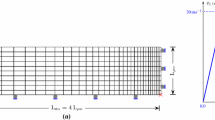Abstract
In the present work a theoretical approach to the problem of failure of non-linear elastic materials is described. This approach is based on the Principle of Conservation of Energy — the total elastic strain energy density in this case. This Principle is equivalent to the path-independence of strain energy, the same not being true for its components, i.e. dilatational and distortional densities. This way, an intimate quantitative relationship is established between the secant bulk, K S , and shear, G S , elastic moduli of the material. Experimental evidence from the open literature in case of a ductile material supports clearly the present predictions.
Access this chapter
Tax calculation will be finalised at checkout
Purchases are for personal use only
Preview
Unable to display preview. Download preview PDF.
Similar content being viewed by others
References
Ali ARM, Hashmi MSJ (1999) Theoretical and experimental results of the elastic-plastic response of a circular rod subjected to non-proportional combined torque and tension loadings. Proc. Inst. Mech. Eng., 213, Part C
Andrianopoulos NP (1993) Metalforming limit diagrams according to the T-criterion. J. Mat. Proc. Tech., 39: 213–226
Andrianopoulos NP, Boulougouris VC (1994) Failure by fracture or yielding in strain hardening materials according to the T-criterion. Eng. Fract. Mech., 47: 639–651
Andrianopoulos NP, Boulougouris VC (2004) Loading path dependence of failure surfaces. Seventh International Congress on Mechanics, HSTAM 2004, Chania
Andrianopoulos NP, Manolopoulos VM, Boulougouris VC (2007) Considerations on failure surfaces in brittle, non linear elastic materials. Eighth International Congress on Mechanics, HSTAM 2007, Patras
Balmer GG (1949) Shearing Strength of Concrete Under High Triaxial Stress. Computation of Mohr’s Envelope as a Curve Structural Research Laboratory Report SP-23, Denver, CO
Bresler B, Pister KS (1958) Strength of concrete under combined stresses. ACI J., 55: 321–345
Chen WF, Han DJ (1988) Plasticity for Structural Engineers. Springer, New York
Desai CS (1971) Nonlinear analysis using spline functions. J. Soil Mech. Found. Div., ASCE, 97: 1461–1480
Desai CS, Siriwardane HJ (1984) Constitutive Laws for Engineering Materials. Prentice-Hall, Englewood Cliffs, NJ
Hansen JB (1963) Discussion of “Hyperbolic Stress-Strain Response: Cohesive Soils”, by Kondner, R.L. J. Soil Mech. Found. Div., ASCE, 89: 241–242
Hsieh SS, Ting EC, Chen WF (1982) A plasticity fracture-model for concrete. Int. J. Solids Struct., 18: 181–197
Kondner RL (1963) Hyperboloid stress-strain response: cohesive soils. J. Soil Mech. Found. Div., ASCE, 89: 15–143
Kotsovos MD, Pavlovic MN (1999) Ultimate Limit-State Design of Concrete Structures: A New Approach. Thomas Telford, London
Kupfer H, Hilsdorf HK, Rusch H (1969) Behavior of concrete under biaxial stresses. ACI J., 66: 656–666
Launay P, Gachon H (1972) Strain and ultimate strength of concrete under triaxial stresses special publication SP-34. ACI J., 1: 269–282
Mills LL, Zimmerman RM (1970) Compressive strength of plain concrete under multiaxial loading conditions. ACI J., 67: 802–807
Nelson I, Baron ML (1971) Application of variable MODULI models to soil behaviour. Int. J. Solids Struct., 7: 399–417
Ottosen NS (1977) A failure criterion for concrete. J. Eng. Mech. Div., ASCE 103(EM4): 527–535
Richart FE, Brandtzaeg A, Brown RL (1928) A Study of the Failure of Concrete under Combined Compressive Stresses. University of Illinois, Engineering Experimental Station Bulletin, 185
Tasuji ME, Slate FO, Nilson AH (1978) Stress-strain response and fracture of concrete in biaxial loading. ACI J., 75: 306–312
Theocaris PS, Andrianopoulos NP (1982) The T-criterion applied to ductile fracture. Int. J. Fracture, 20: R125–R130
Author information
Authors and Affiliations
Corresponding author
Editor information
Editors and Affiliations
Rights and permissions
Copyright information
© 2009 Springer Science+Business Media B.V
About this paper
Cite this paper
Andrianopoulos, N.P., Manolopoulos, V.M., Dernikas, I.T. (2009). Coulomb Failure Surfaces in Ductile Non Linear Elastic Materials. In: Pantelakis, S., Rodopoulos, C. (eds) Engineering Against Fracture. Springer, Dordrecht. https://doi.org/10.1007/978-1-4020-9402-6_11
Download citation
DOI: https://doi.org/10.1007/978-1-4020-9402-6_11
Publisher Name: Springer, Dordrecht
Print ISBN: 978-1-4020-9401-9
Online ISBN: 978-1-4020-9402-6
eBook Packages: Chemistry and Materials ScienceChemistry and Material Science (R0)




